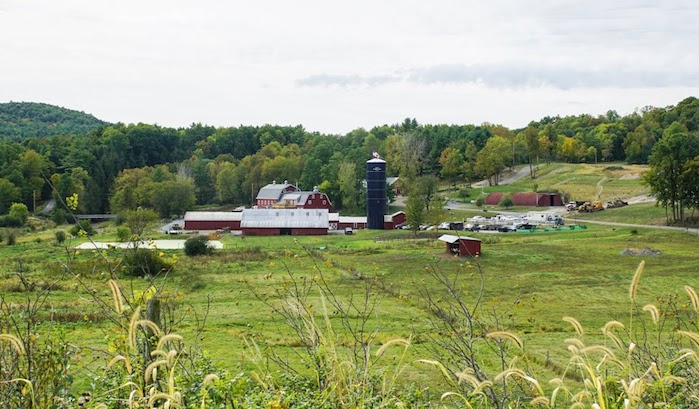Fans of rye whiskey have never had it better. The craft boom has powered a surge of interest in this classic category, leading to an increase in new brands and production techniques. To the latter, rye-makers are now experimenting with different aging methods for this famously finicky spirit.
Including WhistlePig. The premium rye brand already enjoys a reputation for getting the most out of its rye by aging it longer than typical. WhistlePig continues this tradition with its newest offering — a 15-Year-Old rye ($199 per 750-ml. bottle) — while also introducing another aging innovation. To finish the spirit, the Vermont-based company cut down white oak trees around its farm distillery (pictured atop) and turned these into staves for finishing barrels.
I recently spoke with Michael Hodge, WhistlePig National Sales Manager, about their 15-Year-Old and the process that went into making this well-aged, hyper-modern rye whiskey.
BD: Why age rye for 15 years?
 MH: First and foremost, age statements in this market are becoming rarer and rarer. Companies so badly want to put something out on the shelves that they’re blending a lot more and losing the age statements. Just releasing something above 10 years old is an accomplishment in itself. As for 15-year-old rye, I’m only aware of a handful.
MH: First and foremost, age statements in this market are becoming rarer and rarer. Companies so badly want to put something out on the shelves that they’re blending a lot more and losing the age statements. Just releasing something above 10 years old is an accomplishment in itself. As for 15-year-old rye, I’m only aware of a handful.
Now, to be honest, I think that rye grain creates that most flavorful whiskey. Of course, that’s me being subjective. Rye is very robust and spicy, and can be a pretty rough spirit. It requires more time to mellow out. You can produce a quality bourbon in 4-6 years. A rye takes longer to reach that level of complexity and smoothness. We’re always asking ourselves, ‘What is the right age for that?’
BD: But the market right now seems more geared towards younger ryes.
MH: I think that a lot of small craft distilleries are coming into market and need to get something out quickly. This is a difficult business to break into. It’s almost impossible to start off by producing whiskey yourself and aging it for 10 years. You have to have some pretty substantial financial backing to accomplish that.
BD: WhistlePig has always talked about opening its own farm and utilizing the property in making whiskey. The 15-Year-Old seems like the culmination of that goal.
MH: Our goal and mission from our first launch in 2010 has been to build a single-estate distillery. We ran into roadblocks along the way. It took longer than planned. So we thought, what else can we do in the meantime? We realized that we could bring our farm forward and incorporate it into the product. We were already growing rye on the farm, so we looked into how else we could incorporate the terroir into the whiskey.
We have 400-500 forested acres on our land. We’ve spent two years developing a forestry plan. During that time we discovered that we had white oak growing at our farm, enough that we could do something with it. And our neighboring farms also had white oak. So we thought, ‘Why not put all that to use?’.
The joke at the beginning of our company was that we’d be growing all our own rye, milling it with a mule, distilling it onsite, glassblowing our own bottles, and so forth and on. But here we could actually use this farm resource in the form of barrels. Working with an independent cooper, we made barrels out of our Vermont oak.

BD: What’s the difference between this and other oak?
MH: We’ve found that Vermont oak has much narrower and tighter grain than the Missouri oak that’s commonly used for making whiskey barrels. This pulls out more of the lignin and lactone from the oak, which are typically known for vanilla, caramel and butterscotch flavors. And we’ve also found that the Vermont oak is giving our whiskey a creamier, richer mouthfeel.
I’m also picking up this enjoyable vegetal flavor in the 15-Year-Old that I don’t believe I have ever tasted before.
BD: With a price-tag of $199, this is obviously for connoisseurs. How has been their response?
MH: It seems to be all positive so far. The connoisseurs are truly interested in the Vermont-oak aging.
Sometimes people do ask about the price tag. But aging whiskey for 10-plus years is not easy or cheap. There’s also not a whole lot out there anymore at that age. So I think the price is more than justified. I look out there at Scotch and see a lot of bottles at that age selling for that amount. That makes WhistlePig more than worth it.
BD: What’s next from WhistlePig?
MH: We’ll be releasing another Boss Hog this year. This will be our third release in that line. Boss Hog from only our best barrels, and is released at barrel strength. Beyond that, I cannot tell you any more details about this year’s launch.
Kyle Swartz is the associate editor of Beverage Dynamics Magazine. Reach him at kswartz@epgmediallc.com and follow him on Twitter at @kswartzz.










